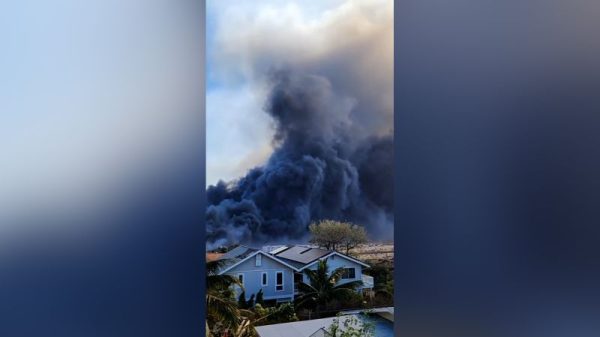Seishi Sato had an ominous feeling when he saw something rustling in a bush during a recent stroll in a forest in northern Japan.
Before he knew it, two Asiatic bears had sprung from the shrub, one charging at him as he frantically tried to fend it off while fearing for his life.
He survived the attack — but not without plenty of scratches and puncture wounds on his arm and thigh.
Sato is among at least 212 people who survived what has been a record year for bear attacks in Japan, according to the Ministry of Environment. Six people have died.
With a month of 2023 still to go, this year’s total has already far surpassed the 158 that took place throughout the whole of 2020 (the previous record year). And the number of bear attacks have never exceeded 200 per year since record began in 2006.
Sightings of “kuma”, or bears, are not unusual in Japan but are generally concentrated in the northern part of the country, where mountain ranges, lush bush and crystal-clear rivers provide an ideal habitat and abundant sources of the acorns, beechnuts, fruits and insects that make up their diet.
But experts say Japan’s bears are increasingly venturing out of their traditional habitats and into urban areas in search of food. Some suggest this is because climate change is interfering with the flowering and pollination of some of the animals’ traditional sources of food.
“Bears are expanding their home range this year and are coming down to areas near human settlements in search of food,” said associate professor Maki Yamamoto, who studies bears at the Nagaoka University of Technology in Niigata.
Increasingly, this is bringing them into the paths of people like Sato, who was attacked just a half-hour walk from the shop he runs, where he sells pet supplies and mushrooms he picks from the forest.
“People are becoming very alert to this situation,” said Sato, adding that other residents had been attacked outside the front doors of their village homes.
As of November, there had been 19,191 sightings across the country, up from 11,135 sightings throughout the whole of the previous year and 12,743 in 2021.
Iwate, where Sato lives, has logged more cases than anywhere else – 5,158 – followed by its neighboring prefecture of Akita, which has reported 3,000 sightings.
So pressing has the issue become that Environment Minister Shintaro Ito pledged last month to help affected communities.
“We are considering providing emergency assistance to local communities in response to their needs, such as surveying and capturing bears living in the vicinity of human settlements, taking into consideration the wishes of prefectures where human casualties due to bears are particularly on the rise,” he told a press conference.
Protective mama bears
Japan is home to two main types of bear: brown bears, which live in Hokkaido, the northernmost of Japan’s main islands, and a small population of Asiatic bears, which reside in Honshu, Japan’s largest island.
Both breeds have an omnivorous diet, enjoy feeding on acorns and tend to avoid humans if possible. An Asiatic bear weighs between 40 and 100 kg while a Japanese brown bear can grow up to 400kg. But both are far from being the biggest bear on earth. Kodiak Brown Bears in Alaska, for example, can weigh up to 600kg.
“Both brown bears and Asiatic black bears are basically timid animals that avoid people,” said Professor Koji Yamazaki from the Tokyo University of Agriculture.
When bears do attack, the cause is usually because a mother bear fears an encounter with a human poses a threat to her cub, experts said.
Sato, who runs the YouTube channel Primitive Forest Bear to share his adventures in nature, recalled that the Asiatic bears he ran into appeared to be mother and child.
He captured the attack on camera and posted the video online as a reminder to others to take care.
The video, which has since gone viral, shows him screaming for his life and hitting the animal with a tree branch to drive it away. At one point, he climbs a tree to avoid being mauled. Luckily, the bear eventually turns away.
“When I saw the video, I was scared to death,” Sato said.
Climate change and population shifts
With encounters on the increase, some experts believe climate change may be a factor in pushing bears further from their traditional habitats.
“The thing is that you can have years of bad harvests and years of good harvest of acorns. And when the harvest is bad, the bears cannot store enough energy before hibernation by eating mountain acorns alone, so they get closer to human settlements looking for fruits, chestnuts, persimmons, walnuts, and farm products in general,” Yamamoto, from Nagaoka University of Technology, explained.
“This year, bears have been appearing more in the villages precisely because of the very bad harvest of acorns from the beech, the bears’ favorite tree,” she said.
Tsutomu Mano, a senior research fellow at the Hokkaido Research Organization, said climate change “is likely to have a significant impact on the flowering time of plants and the activity of insects responsible for pollination, which is necessary for fruiting.”
And when the bears don’t have enough food, they often turn to human neighborhoods to look for leftovers in the bins, he said.
Once they’ve developed a taste for human leftovers they will keep returning for more, Mano said.
Another factor that some believe may be coming into play is Japan’s rapidly shifting demographics.
With a median age of 48, Japan has one of the world’s oldest populations, according to the Economic and Social for Asia and the Pacific, a United Nations’ arm that tracks population trends.
At the same time, the country is experiencing a shift in which younger generations are increasingly moving to big cities for better job opportunities.
Taken together, the two factors mean populations on the rural edges of northern prefectures are fast dwindling, creating conditions such as “abandonment of cultivated land and overgrowth along riversides” that “make it easier for bears to enter,” according to Mano.
According to national broadcaster NHK, out of the 71 people attacked by bears in October, 61 were above the age of 60. Twenty-one people were in their 80s.
On October 24 alone, four people – all in the 70s – were injured in Akita on the same day, the broadcaster reported.
What’s the solution?
At Karuizawa, a resort town located in Nagano prefecture, northwest of Tokyo, conservationists have taken to patrolling the forest with dogs to scare the bears away, according to local media.
But officials in Akita prefecture, which recorded the second-highest number of bear attacks, have a more drastic measure in store. They have begun offering rewards to trappers.
Governor Norihisa Satake announced late last month a 5,000-yen ($33) prize for each bear captured in the prefecture. The authorities are also mulling a proposal to set aside a fund of up to 15 million yen ($100,000) to pay for the transportation of the captured bears.
But experts say a more holistic approach is needed.
“Trapping is not sufficient to manage bears, so it is necessary to consider a combination of various methods,” said Yamazaki, from the Tokyo University of Agriculture.
The first step was to study what types of bear – in terms of their ages, genders and locations – were going astray and why, he said.







































